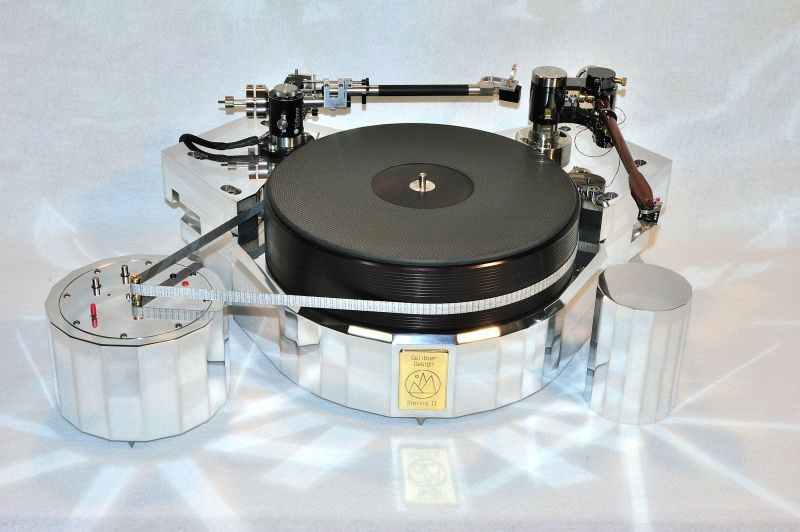Laurence Borden: Thom, welcome to Dagogo. You were one of the original members of the team that set out to build a turntable based on the published plans of Thomas Scheu in Germany. I know it’s a long and complicated story, with enough drama for a made-for-TV movie, but perhaps you give us the short version so as to provide some background as to how Galibier began.
Thom Mackris: Chris Brady and I met through the newsgroup, rec.audio.tubes in 1998. Both of us were inclined toward rolling our own gear, and some six months after I re-introduced him to vinyl, we began investigating building turntables designed by Thomas Scheu.
The conversation picked up momentum, and one gray Saturday in December of 1999, while everyone else was waiting for the sky to fall on January 1st of the new millennium, Chris and I were at a coffee shop reviewing Thomas Scheu’s plans.
Chris and I decided it would be much more fun to develop our own turntable – one that reflected our design philosophy, which amongst other things included non-inverted bearings.
We found three other willing “victims” and collectively designed the bearing and platter over the next five weeks. At that point, we reached out to friends in the DIY community in order to expand the numbers and reduce the per unit machining cost. The group expanded to approximately 16 – not quite the 25 we were aiming for. I put a post out on the Sound Practices mailing list (aka the “Joe List”). Be careful what you ask for – our merry group was nudging up against 60.
Parts were awaiting fabrication, ultimately being delivered in the Summer of 2000. During this time, we communicated on a mailing list hosted by one of the Joe List members from the Washington DC area. One participant was a Joe Lister named Manfred Huber, who donated his intellectual property of a motor controller design to the project.
As is typical of our breed, we discussed all sorts of angels on the head of a pin types of issues during this period.
A key philosophical difference arose from these conversations and two camps formed. They came to be known as the “stiffies” and the “woodies.”
The “stiffies” (which ultimately spawned Redpoint and Galibier) argued that it’s far easier to use rigid materials (like aluminum) and to damp them, than it is to use inherently damped (but flexible and dimensionally unstable) materials like wood (embraced by Chris and the “woodies”). The “stiffies” argued that aluminum machines more accurately, and when used in turntable bases, the critical distance from arm mount to record spindle (bearing) is maintained with far more precision (less flexing).
In mid-2001, Peter Clark (one of the early adopters of the Teres build) and I formed Redpoint Audio Design to further explore our ideas. Ours was a dynamic and productive collaboration, especially when taking into consideration our virtual relationship – operating out of two cities, 900 miles apart (Scottsdale, AZ and Erie, Colorado).
By 2003, the logistical challenges of operating at a distance, coupled with Peter and I wanting to explore different business models led to our split. I left Peter with the Redpoint name and launched Galibier.
LB: As with most things in audio, there are numerous opposing ideas in turntable design. For example, some favor high-mass platters, others lighter mass ones; some favor suspended designs, while others eschew suspensions, and so on. To help us understand the raison d’etre behind Galibier ‘tables, and how they evolved from the earliest prototypes, I’d like to explore these various parameters with you. Let’s begin with what may be the most fundamental decision a designer must make, namely the type of drive to be employed. Why did you select belt-drive for your turntables, rather than direct- or rim/idler wheel drive?
TM: Let me work you backwards from the conclusion, to the thought process that led to it.
I viewed optimizing a belt drive architecture to be a challenge that could be solved in the simplest, most elegant and balanced manner – a solution which would also result in ease of maintaining manufacturing quality and precision. Addressing the issues with direct and rim drive were far more complicated, with no expected up-side.
I also saw belt drive architecture as conferring another significant advantage – its suitability to modularity. Modularity provides two key benefits to the customer: ease of service and the potential for reduced cost of upgrades. This is not a trivial point, and I need to expand on this.
Our recently released drive system upgrade is 100% compatible with every turntable Galibier has ever manufactured. Installing the upgrade can be done by the end-user in 10 minutes – 8 screws and a power plug. Modularity done with forethought means that expensive, machined parts are reusable.
In comparison, one high-mass, rim drive turntable I know of, requires a manufacturer visit in order to obviate the need for shipping 200 pounds of turntable back for diagnosis, service and repair.
Parts reusability, and more importantly, conveying the coherence of our vision is the key reason we posted a “Galibier Museum” section on our website. We liken the evolution of our designs and their longevity in much the same way we do a Porsche or Ferrari. Contrast this philosophy with the vast majority of audio products whose lifecycles resemble that of a cell phone or computer. Do you really want to spend upwards of five figures on a component that becomes obsolete as you walk out the door?
My thinking about audio design had been evolving to a position that as varying design architectures mature, there is a sonic convergence. Great push-pull amplifiers will sound more like great single-ended amplifiers (when paired with compatible speakers), planar speakers and horns will sound more alike (driven by appropriate amps) … that sort of thing.
Of course, the basic attributes of the architecture will exist. The radiation pattern and room coupling of a horn will always differ from that of a planar speaker. If however the designer is clever, and he mitigates the challenges/weaknesses of the architecture with an eye/ear toward musical balance, he can present the listener with a difficult choice when choosing between competing architectures.
Ken Stevens of Convergent Audio Technology once laid out the visual metaphor of a target to describe various distortion types, and ultimately the strengths and weaknesses of a design. Think of a dart board with the various distortions represented as points scattered over all 360 degrees and at varying distances from the bull’s eye.
Now, divide the dart board into three equal pie slices and ascribe belt, rim, and direct drive to each of the three slices.
The farthest points from the bull’s eye represent each architecture’s weaknesses and the closest points are the architecture’s strengths. In an idealized model, all architectures would hit the bull’s eye with each parameter. There would be perfect convergence and no difference between them.
Back to reality …
For belt drive, the strengths are low noise floor (preservation of delicate details) and its challenges are drive coupling and speed stability. Idler and direct drive architectures have the reverse design challenges to address – reducing noise and transmitted vibration.
I was confident that improving drive coupling in a belt drive architecture would be far easier to accomplish than the challenges direct and rim drive architectures pose to preserving low level detail. In retrospect, I’m very comfortable with this decision, with the key elements being to remove compliance by employing a rigid belt and eliminating the suspension.
One thing I find amusing is how we (as audiophiles) choose an architecture du jour and anoint it as the single path to salvation. In the past 5 years, rim and direct drive have returned to fashion.
My response to this is to reference the approach Doug Sax took while at The Mastering Lab. He used a combination of Neuman and Scully mastering lathes, and his architecture of choice involved using one of the lathes as a drive system for a second one … connecting them by … a cloth belt.
- (Page 1 of 5)
- Next page →




Thom has guided me from afar. I appreciate his engineering sense as I am also a prototype machinist. I am very grateful for this man’s influence.